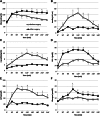Removal of duodenum elicits GLP-1 secretion
- PMID: 23393218
- PMCID: PMC3661831
- DOI: 10.2337/dc12-0811
Removal of duodenum elicits GLP-1 secretion
Abstract
Objective: To evaluate the effect of removal of the duodenum on the complex interplay between incretins, insulin, and glucagon in nondiabetic subjects.
Research design and methods: For evaluation of hormonal secretion and insulin sensitivity, 10 overweight patients without type 2 diabetes (age 61 ± 19.3 years and BMI 27.9 ± 5.3 kg/m(2)) underwent a mixed-meal test and a hyperinsulinemic-euglycemic clamp before and after pylorus-preserving pancreatoduodenectomy for ampulloma.
Results: All patients experienced a reduction in insulin (P = 0.002), C-peptide (P = 0.0002), and gastric inhibitory peptide (GIP) secretion (P = 0.0004), while both fasting and postprandial glucose levels increased (P = 0.0001); GLP-1 and glucagon responses to the mixed meal increased significantly after surgery (P = 0.02 and 0.031). While changes in GIP levels did not correlate with insulin, glucagon, and glucose levels, the increase in GLP-1 secretion was inversely related to the postsurgery decrease in insulin secretion (R(2) = 0.56; P = 0.012) but not to the increased glucagon secretion, which correlated inversely with the reduction of insulin (R(2) = 0.46; P = 0.03) and C-peptide (R(2) = 0.37; P = 0.04). Given that the remaining pancreas presumably has preserved intraislet anatomy, insulin secretory capacity, and α- and β-cell interplay, our data suggest that the increased glucagon secretion is related to decreased systemic insulin.
Conclusions: Pylorus-preserving pancreatoduodenectomy was associated with a decrease in GIP and a remarkable increase in GLP-1 levels, which was not translated into increased insulin secretion. Rather, the hypoinsulinemia may have caused an increase in glucagon secretion.
Figures


References
-
- Umeda LM, Silva EA, Carneiro G, Arasaki CH, Geloneze B, Zanella MT. Early improvement in glycemic control after bariatric surgery and its relationships with insulin, GLP-1, and glucagon secretion in type 2 diabetic patients. Obes Surg 2011;21:896–901 - PubMed
-
- Näslund E, Grybäck P, Hellström PM, et al. Gastrointestinal hormones and gastric emptying 20 years after jejunoileal bypass for massive obesity. Int J Obes Relat Metab Disord 1997;21:387–392 - PubMed
Publication types
MeSH terms
Substances
LinkOut - more resources
Full Text Sources
Other Literature Sources

